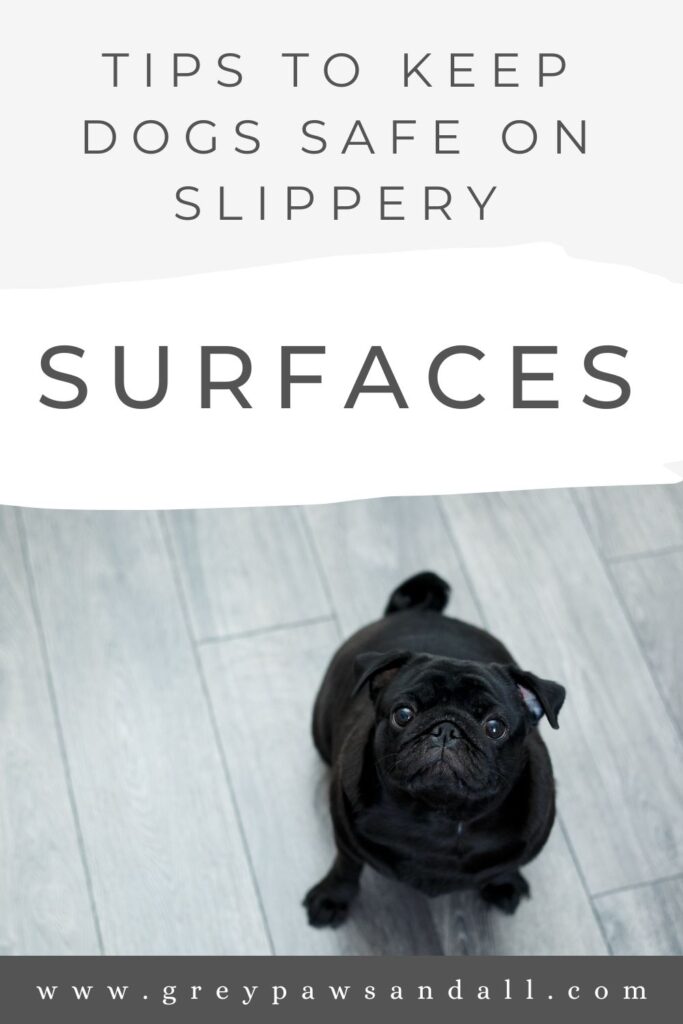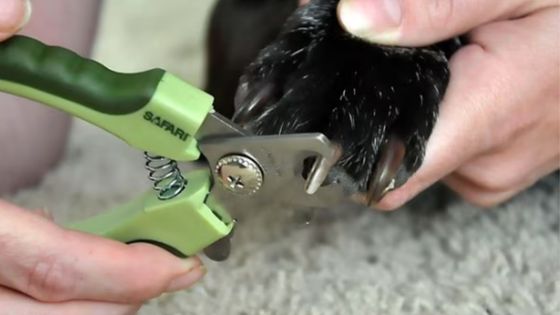As your dog ages, you may find he’s sliding on floors more often than he used to.
If your dog is having trouble getting traction on your floors, things like yoga mats, area rugs, interlocking foam mats and cutting the fur on his paws can make all the difference.
*There are affiliate links in this post, so if you make a purchase I may receive a small commission. This does not change the price you pay, but does help me continue bringing you helpful content.*
It’s not uncommon for dogs of all ages and sizes to slip on some types of flooring. Tile, laminate, vinyl and hardwood are examples of surfaces hard to gain traction on. With older dogs more prone to mobility issues, getting a grip can be even more of a challenge.
Why Your Senior Dog is Slipping on the Floor
- Your dog’s claws can grip carpet, but not slippery surfaces
- Dry and chapped pads make it harder to get traction
- Nails are overgrown
- Hair is too long between his toes
- Torn ACL/sprain/fracture
- He was never taught to experience various floor textures as a puppy
- Back leg weakness, arthritis and other mobility issues
- He may have had a bad experience, perhaps he fell, and how he’s wary and uncomfortable
- Your dog is overweight, making him less agile and more prone to sliding
- Vestibular disease (the dizziness makes him unsteady on his feet)
Can Slipping Cause Injury to Your Senior Dog?
The simple answer is “yes” it can, in the form of sprains to a more serious case of broken bones. Please also consider recovery time and possible long term issues as a result of injury.
Not only can slipping cause injury it can also be difficult, and in some cases impossible, for your dog to get up.

How to Prevent Your Dog Slipping on the Floor
The one thing I can say is, all the suggestions I list are recommendations from dog parents I know in person and through my FB group, as well as what I’ve had success with. As is to be expected, what works for one may not work for another, so sometimes it’s a case of trial and error.
Research some of the products, read what they’re all about and check out the reviews as well. You may also want to see if any of them have a money back guarantee in case you’re not satisfied. I know experimenting can get costly.
Solutions for the Home
Slip Doctors Floor Grip Anti Slip Coating
This is a non slip coating you apply over your flooring, and the manufacturer claims one application lasts 2 years. It is safe for wood, vinyl, linoleum and laminate flooring, and recommended specifically to help dogs who slip on floors.
I don’t have any personal experience with this product, but I did read some very good reviews. It’s worth doing your research to see if this is something you’d be interested in trying. Visit their website for more information and to order.
Baby Gates
While it’s nice to allow our dogs free access to the entire home, safety is key. if there are some trouble spots, baby gates are a great solution.
Floor Coverings
Yoga mats, area rugs, interlocking foam or rubber mats/rolls and the like will stop your dog slipping. Some dog parents don’t like the way they look, so these are not viable options. There are stunning rugs out there, but if you’re loving your tile floor this is probably not the option for you.
For a long time I had pee pads covering my entire floor. I must admit it wasn’t the most attractive look, but my heart dog Red had kidney issues and dementia, and as many times as she went out, she would still pee inside. I would rather look at pee pads (and have her back with me) then walk into a room and find pee stains on the carpet.
Carpet Your Home
If you have the funds and you don’t mind the look of carpet, you may consider this as an option.
Solutions for Your Dog’s Paws
Paw balms
Since dry, cracked pads can make it harder for dogs to grip slippery surfaces, why not try a moisturizing paw balm! There are plenty of products on the market to look into, or you can make your own. I’ve used paw wax on my dog and it made a big difference.
Recommended products:
Musher’s Secret – Developed in Canada to protect the paws of sled dogs, this natural product is also popular for helping dogs who slip on floors.
Show Tech Paw Grip Anti Slip Spray – Designed to give show dogs traction on slippery surfaces, no reason it won’t work for your dog as well. A search will show suppliers in your area.
Ruff Relief Organic Nose & Paw Wax – Moisturizes dry and cracked paws, helping your dog get a better grip. It’s organic and made in the U.S.A.

Anti slip grips, socks and booties
Self adhesive paw stickers are stickers you put on the bottom of your dog’s paws. Many dog parents are happy with the results, and Loobani is a brand that was recommended by several. Safety note: Some dogs do chew them off so you have to be careful. The last thing you want is to solve one problem, only to be rushing him to the vet with a possible obstruction!
Dr Buzby’s ToeGrips are non slip grips that fit over your dog’s nails. Considered to be pricey by some dog parents, they work well for many but as with most things, not for all.
Summit Trex™ Dog Boots by Ruffwear are one brand highly recommended by dog parents. They found they gripped well and helped their dog get around their home in a safer manner. This is another brand of dog bootie a few people mentioned as well.
Pawz Dog Boots are another recommended choice. They’re made of rubber and literally look like balloons. When I was in Toronto last winter I saw a ton of dogs wearing them to protect their paws from the salt, and everyone told me how great they were. They were so popular it was hard to find sizes. They run quite big in my experience so research before you buy. My dog is a Maltese mix, roughly 10lbs and if I remember correctly he needed the x-small. I wouldn’t keep them on 24/7, it’s important to let your dog’s skin breath.
Vet Wrap – I haven’t tried this to prevent slipping, but the idea popped into my head that it might be an option. My various dogs have had vet wrap on their arms after blood tests and IV, so I know how easy it is to use and won’t stick to their fur. Before you buy it, ask your vet if he can spare a small piece for you to try. Just be careful not to wrap it too tightly. I went to pick up my dog Red from the vet one day, and by the time I got home I realised her paw was swollen from a bandage that was wrapped too tightly.
Non skid socks are thinner and lighter than booties, which may make them more comfortable for some dogs. When choosing, take note of how much grip is on the bottom, as some have more than others. If you find them in a pet supply store you may be able to try them on your dog before you buy. I was able to do that and I found it helpful. Once I put a pair on Jack and had him walk a bit, I quickly realised there wasn’t enough grippy bits on the bottom and he was still sliding. It saved me a trip back to the store for a refund.
*Helpful tip #1*
If you’re having trouble keeping non skid socks on your dog’s feet, sew a piece of yarn onto the back then tie it around the ankle or across the top of the sock.
*Helpful tip #2*
A lot of dogs, mine included, are not happy about having something on their feet. Here’s what you can do to increase the chances!!
Depending on how stubborn (in my life his name is Jack!) your dog is, you may need to go through all the steps. If yours is more easy going, you may be able to start at a later step, or move through them more quickly. My advice is to not rush, you’ll increase your chances of him tolerating them if you take things slowly.
Repeat each step a few times, and don’t advance until he’s receptive.
Step 1 – Show your dog a sock or bootie and give him a treat.
Step 2 – Put it near your dog’s foot, take it away and treat.
Step 3 – Put it partially onto his foot, remove and treat.
Step 4 – Cover his foot, remove and treat.
Step 5 – Leave it on to the count of 1, remove and treat. Repeat this step, each time increasing the count by 1. Always treat after removing it.
Step 6 – Repeat with the other foot.
Step 7 – Walking with them on both feet will take some getting used to. Some dogs lift up their paws like they’re walking over hot coals! Keep them on for a very short time, maybe a minute or two depending on how he’s reacting, take them off, treat and practice again later.
It’s very possible even after all this step-by-step acclimating exercise, your dog will refuse to wear them. If that’s the case let it be and give them away or sell them. Don’t force the issue, you’ll find something else.
Keep Your Dog’s Nails Trimmed

Not only can long nails not grip surfaces, they can make it extremely painful for your dog to walk. If you aren’t able to cut them on your own, have your groomer or someone at your vet’s office do it. I used to take one of my dogs to a pet supply store that had a grooming service which offered $5.00 nail trims for old dogs.
Cut the Hair on the Bottom of his Paws
One suggestion that has been extremely helpful was clipping the hair on the bottom of the paws. Keeping it short goes a long way to reducing the sliding issue.
What to Do If Nothing Helps
Whether you dog is just slipping or also struggling to get up, a visit to your vet is in order. Mobility issues can make it painful for a dog to not only walk, but also get up from a laying down position. Vestibular disease or an ear infection for example, can cause dizziness and an inability to walk properly, which is why it’s important to get to the bottom of the problem. Medication, supplements and even products like harnesses may be the answer.
While I do believe covering slippery surfaces with mats is the right decision, this article “5 Effective Ways to Reduce Pain in Dogs with Arthritis” is filled with lots of helpful ideas if your dog is dealing with a painful joint condition.
What tricks have you found that stop your pup from slipping? Sharing helps others so let us know in the comments section.
If you’re looking for a community of senior dog parents, a place where you can find helpful tips, support and people who “get it” please join my FB group Senior Dog Care Club
I help senior dog parents struggling with anticipatory grief and quality of life issues by offering practical tips, advice and one on one support. I am also a Certified Pet Loss Specialist, helping you navigate through your pet loss journey.
Click this link to book a FREE 20 minute discovery call, visit my service page to find out more or email hindy@greypawsandall.com if you have any questions.
I’ve been rescuing and caring for senior dogs since 2009. From vision and hearing loss to obesity, dementia, kidney disease, liver issues, cardiac problems, Cushing’s, mobility challenges and more, you could say I’ve dealt with and learned a lot! In addition to my hands on experience, I’ve taken many courses and earned several qualifications to keep learning how to help senior dogs and they include: Senior Dog Enrichment, Understanding Canine Anxiety, Care of the Senior Pet and I’m a Certified Pet Loss Specialist.

